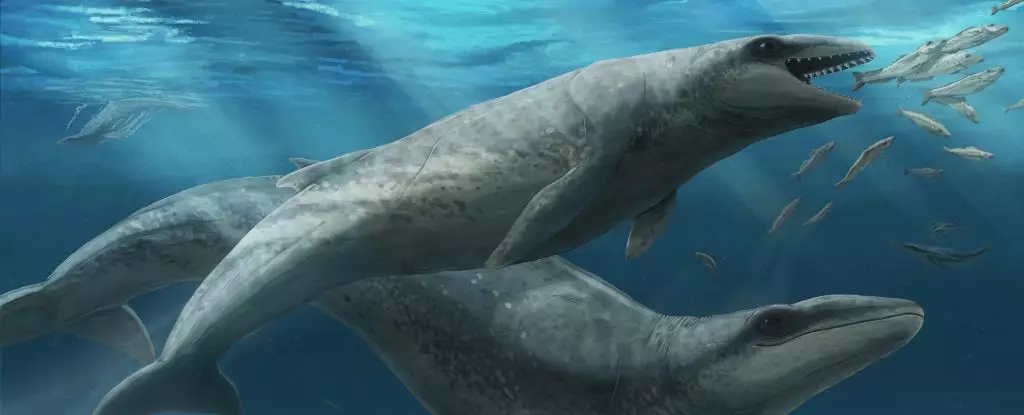The discovery of Janjucetus dullardi shatters the simplistic narrative we’ve long held about whale evolution. For so long, we’ve been told that whales evolved from small ancestors and gradually transformed into the enormous creatures dominating today’s oceans. However, this groundbreaking fossil tells a far more complex story—one where diminutive whales once reigned supreme in a vibrant, predator-filled ecosystem. As a supposed evolution of grandeur, the narrative of whales ballooning in size over millions of years is shown to be only part of the picture. These tiny but ferocious whales challenge our assumptions, revealing that evolution is often a chaotic, unpredictable process, not a steady march toward gigantism.
This paleontological find not only emphasizes the diversity that once populated marine habitats but also beckons us to reconsider the narrative of adaptation and survival. The tiny Janjucetus, about the size of a human or a prehistoric penguin, was a fierce contender in its niche—armed with razor-sharp teeth and sharp eyesight. To view these creatures solely as primitive ancestors destined for the colossal whales we see today is shortsighted. Instead, their existence underscores the competitive and dynamic nature of prehistoric marine ecosystems where size was not always an advantage.
Rethinking Whale Evolution: More Than Just Size
The discovery of Janjucetus dullardi profoundly complicates our understanding of marine evolution by illustrating that size isn’t the ultimate indicator of ecological success. Unlike the enormous baleen whales that dominate modern seas, J. dullardi was a predator, employing its sharp teeth and keen senses more akin to sharks than to the baleen filter-feeders we associate with today. Morphological features such as its eyes and ear bones illuminate how these animals navigated their environment, suggesting that sensory adaptation played a crucial role in their survival strategies.
What is particularly intriguing is that these prehistoric whales possessed teeth, unlike the iconic baleen structures of their modern descendants. This indicates that baleen whales did not evolve directly from these small, toothed ancestors but rather, that these creatures represent a divergent experiment in marine mammal evolution. It beckons us to confront the idea that evolution isn’t a linear journey toward larger, more ‘advanced’ forms, but a complex web of adaptations driven by ecological needs, competitive pressures, and environmental changes.
Moreover, this fossil raises questions about the reasons behind the eventual decline of such small, predatory whales. Did changing oceanic conditions favor larger, filter-feeding whales? Was the extinction of the mammalodontids a result of shifts in prey, climate, or competition? These questions challenge the simplistic notion that bigger is always better when it comes to evolutionary success, instead pointing to a nuanced interplay of factors that shape life’s diversity.
Implications for Future Research and Conservation Perspectives
Drawing from this discovery, it becomes clear that our understanding of marine life’s past is still in its infancy. The detailed preservation of the inner ear and teeth in J. dullardi provides invaluable insights into sensory capabilities and feeding behaviors of ancient whales, offering clues about their ecological roles. Recognizing that such small predators once existed in abundance urges us to rethink modern conservation strategies, emphasizing the importance of preserving a broad diversity of marine species, not just the largest or most charismatic.
In a broader sense, these findings serve as a reminder of the importance of humility in science. Every new fossil challenges existing paradigms and urges us to reconsider our assumptions about evolution’s trajectory. It is a stark reminder that the ocean’s history is richer, more complex, and far more surprising than we often acknowledge. As we face environmental challenges today—climate change, overfishing, habitat destruction—the story of tiny whales like J. dullardi underscores the importance of protecting the full spectrum of marine biodiversity, including the often-overlooked small and seemingly insignificant species that have played pivotal roles in our planet’s biological tapestry.
This discovery is not just a glimpse into the past but a call to deepen our curiosity and responsibility toward the oceans. The miniature yet fierce whales that once swam around Australia are testament to nature’s extraordinary capacity for diversity and adaptation—a legacy that challenges us to act thoughtfully and passionately in preserving what remains.


Leave a Reply